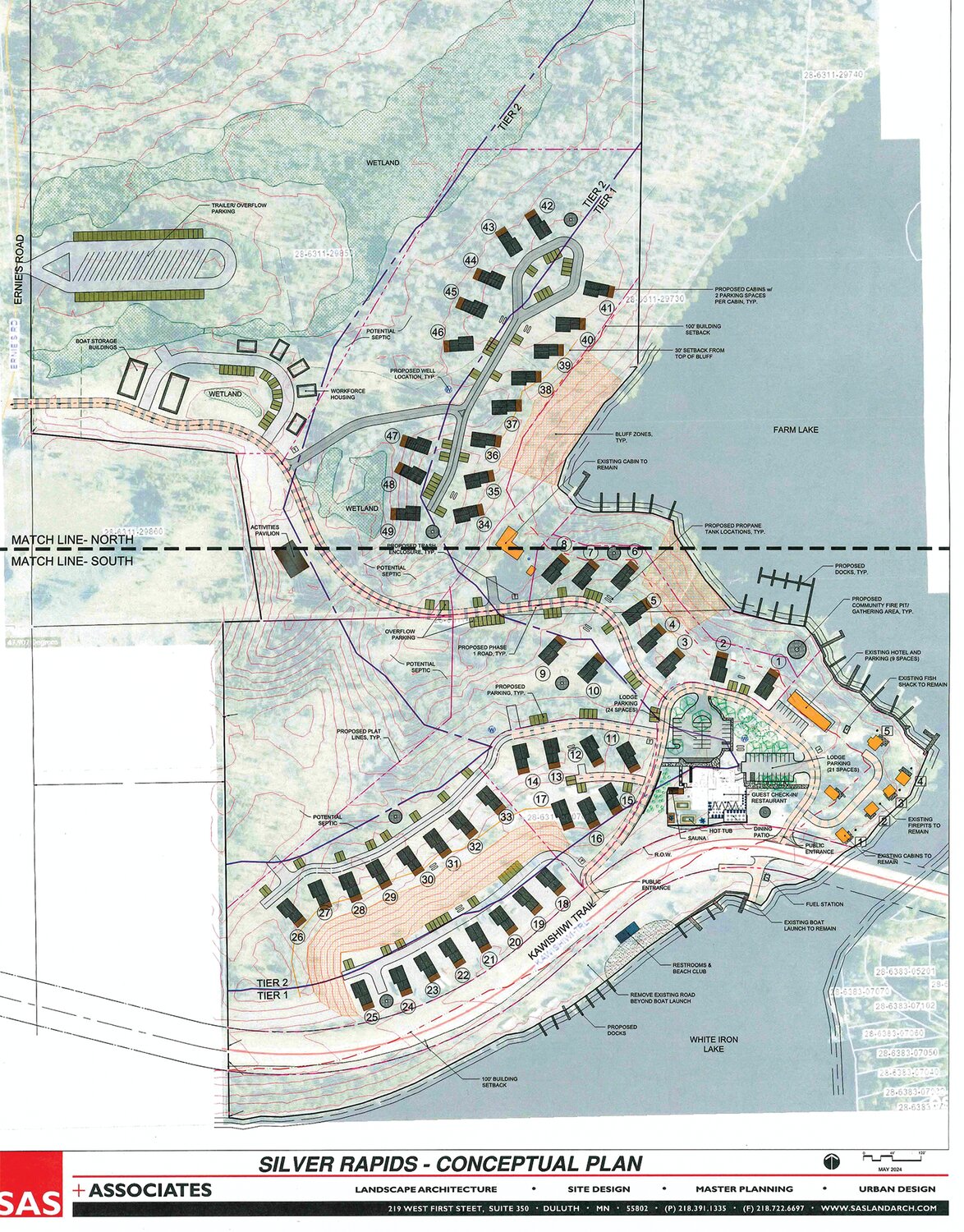Support the Timberjay by making a donation.
Silver Rapids proposal gets the green light
TWO HARBORS- In an action that surprised no one, the Lake County Planning Commission granted both a preliminary plat and a conditional use permit, or CUP, on Sept. 4 to the developers of the Silver Rapids resort, located near Ely.
The decision is certain to anger neighbors of the development who have turned out in large numbers at recent meetings to express their concerns about the scale and density of the proposed development. Local reaction will be addressed in an upcoming Timberjay report.
In granting the CUP, Lake County did impose 20 distinct conditions, which highlighted the county’s intent to rely on its own permitting processes and other regulatory agencies to address a number of environmental concerns, including wastewater, water supply, lodging unit density, and storm runoff, during permitting for the project.
The Lake County Environmental Services Department, which includes its planning and zoning division, sent a memorandum on Aug. 6 summarizing the findings and conditions to the developers of the Silver Rapids Resort LLC. The memorandum is not the official notice of “findings of fact” and conditions. The county has 30 days to record the findings and permit conditions as “official minutes” of the planning commission, and those will have the force of law.
The conditions
The CUP approved last week included twenty conditions which are listed below, which the Timberjay has lightly edited for clarity:
• Occupancy limits and the total approved number of units allowed will be determined by the approved, final septic design for the site. Bonding will be required in an amount to be determined by the County Attorney.
• A DNR water appropriation permit must be attained prior to issuance of any land use or septic system treatment permits for phase two construction.
• The lodging establishment is subject to, and grantee must comply with, Lake County Health Department and Minnesota Department of Health requirements.
• Final site plan to be submitted to Lake County planning and zoning by Nov. 1, 2024.
• Emergency response and FireWise plans shall be developed and submitted to Lake County planning and zoning.
• No retail sales at White Iron Lake beach, only a bathroom and shade structure per the approval of a variance through Lake County.
• Units not to exceed 33 in Tier 1 and 29 in Tier 2.
• No discharge of fireworks or firearms allowed on site.
• All outdoor fires must be limited to designated fire rings.
• Quiet hours must be observed between the hours of 10 p.m. and 7 a.m.
• There must be management onsite during resort operations.
• The use of RV campers and park models on site is prohibited.
• All vehicles and trailers must be contained on the property; on-street parking is prohibited.
• Dwelling units located in bluff and shoreline structure setbacks may not be expanded in any exterior dimension.
• An aquatic invasive species prevention plan is required, which shall be reviewed by Lake County Soil and Water Conservation District and the White Iron Chain of Lakes Association with final approval from Lake County Planning and Zoning prior to the certificate of occupancy of the main lodge.
• A site plan of docks and water facilities shall be submitted to planning and zoning and the DNR to determine if permits are necessary.
• The use of jet skis shall be highly discouraged, including no rental of jet skis.
• The number of docks and mooring sites not to exceed the plan proposed on Aug. 6.
• Rental of boats shall be limited to resort guests and unit owners.
• Fractional units shall be limited to rental of one party per unit; lockouts are considered multiple units.
The density issue
The single largest concern expressed by most local residents is scope of the resort makeover, which will increase the occupancy of the property from 280 to 400 people. Many have expressed doubt that such an increase in usage can be achieved without significant environmental and cultural impacts.
The 49 cabins and their square footage is a key issue because the residential space inside the timeshare cabins plays a leading role in determining the maximum density to avoid an environmental assessment worksheet.
After a half hour verbal tussle at the beginning of the meeting over how to calculate the timeshare square footage, the county approved 33 lodging units for the tier one setback zone, which includes the motel and the five grandfathered cabin on the shoreline, and the 29 units in the tier two setback zone. The total number of units will be 62.
The original proposal submitted to the county on May 31 was for 36 units in tier one and 25 in tier two, for a total of 61. The result is that the county did not significantly change the one thing that concerns area residents, namely a large increase in the number people who will visit the resort. Both the county and the developers have not taken any steps to address resident fears that the resort will destroy the quiet, paddle-oriented nature of the White Iron chain of lakes. The lack of transparency and a seeming unwillingness to engage with Fall Lake area property owners has solidified resistance to the resort makeover, which will be the topic of an upcoming article in the Timberjay.






